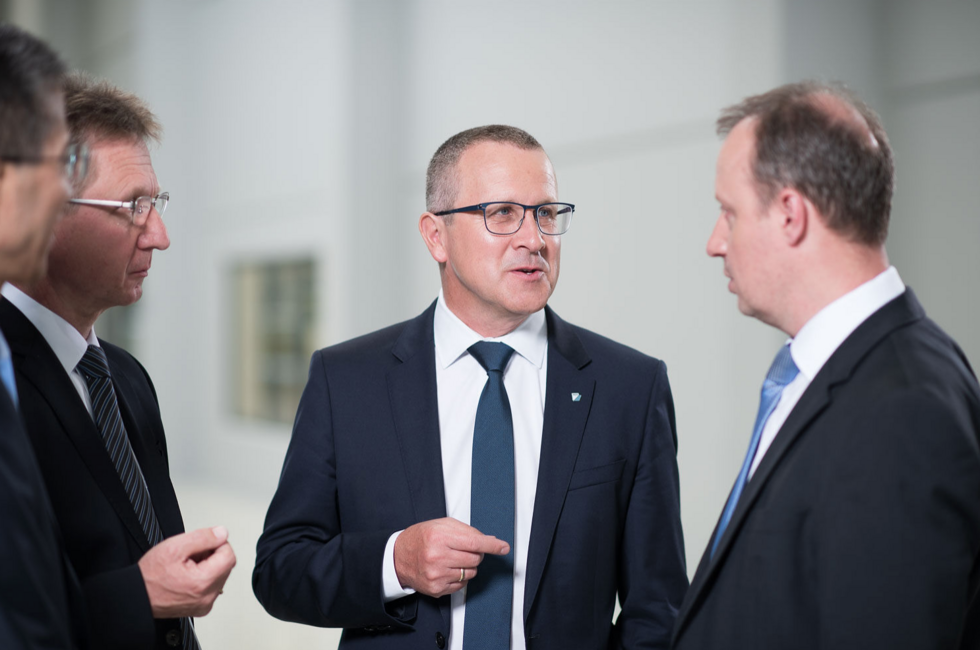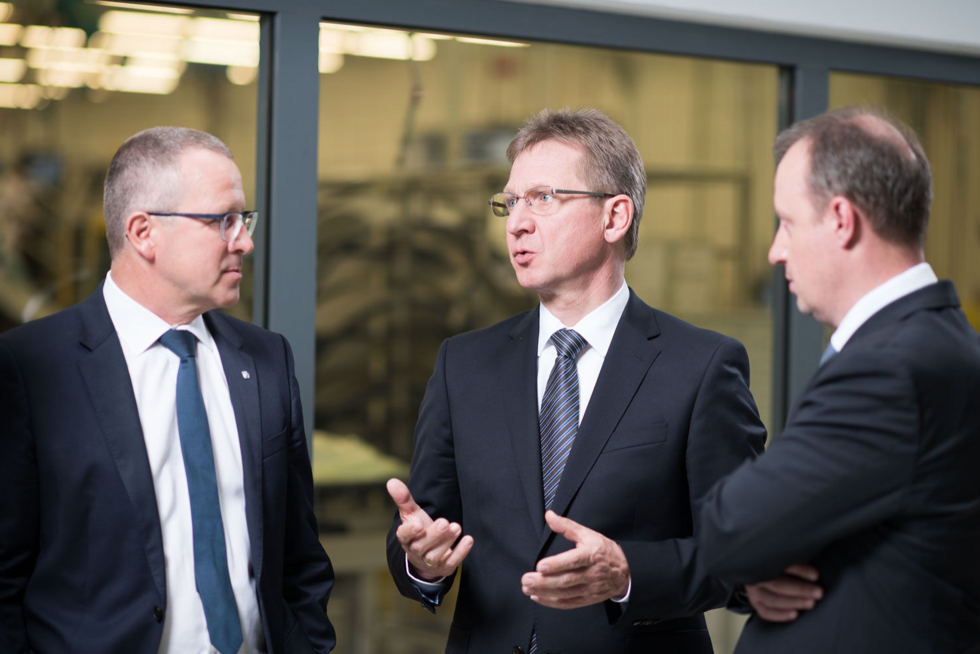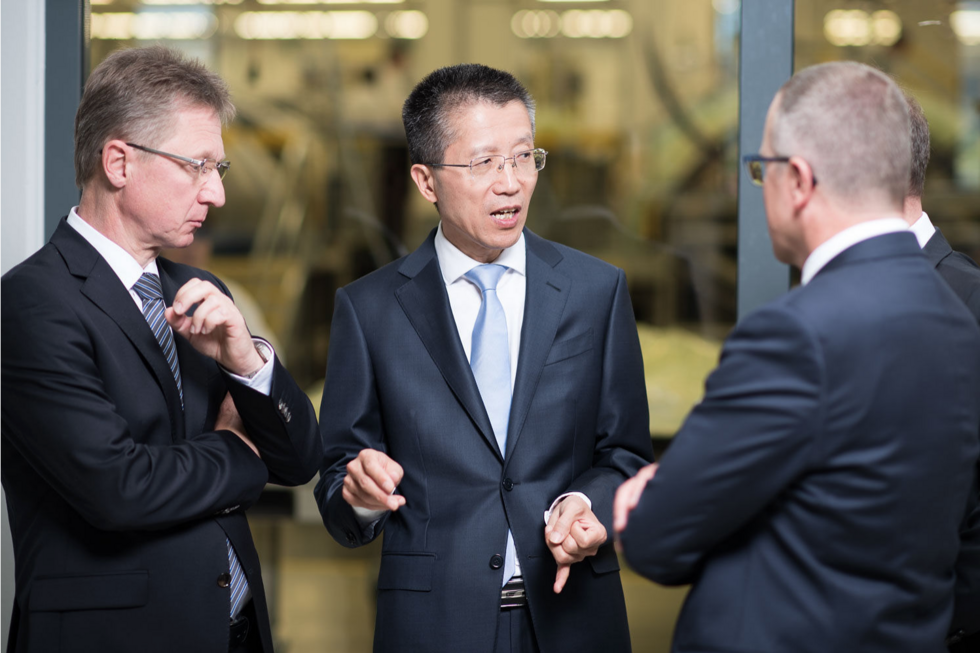An interview with the management team of FACC AG, Robert Machtlinger (CEO), Andreas Ockel (COO), Aleš Stárek (CFO) and Yongsheng Wang (CCO), on innovation, new fields of business and long-term profitable growth in a very challenging market FACC AG
Mr. Machtlinger, FACC celebrated several anniversaries in 2019: 30 years of company history, ten years of AVIC as majority shareholder, five years of being listed on the Vienna Stock Exchange. This is the perfect occasion to take a look back, isn’t it?
Robert Machtlinger:
Absolutely, our company has undergone a truly impressive development. Over the past three decades, FACC has developed from a SME to a global corporation. A strategically significant Chinese aerospace group has accompanied us on this path as our main shareholder over the past ten years, and we have been able to count on many other institutional and private investors in the last five years. In order to take a look back on these multiple anniversaries with us, the aircraft industry from all corners of the globe came together in Upper Austria in June 2019. We were particularly pleased that all of our major customers from day one were also present. You could sum it up with the short formula “A-B-C” – Airbus, Boeing, Collins – because these three customers have been with us from the very beginning, which creates a special bond and motivates us to try new things. Fortunately, it didn’t just stay at these three customers, so we were able to welcome all of our numerous customers including our most recent partner EHang, with which we are jointly developing brand new technology. In addition to our customers and partners, we of course also celebrated with our employees on the FACC Campus. However, we are not dwelling on the past, but are instead focusing on the future ...
Before we take a look into the future – which is currently difficult to anticipate due to the coronavirus in particular – let’s stay in the recent past. What was 2019 like overall?
Robert Machtlinger:
2019 was another eventful year, both on the market and at FACC itself. As far as the aerospace industry is concerned, we are currently experiencing consolidation dynamics at an unprecedented scale. On the one hand, I am thinking here of OEM mergers such as that of Airbus and Bombardier, followed by Boeing and the commercial division of Embraer. On the other hand, we are also witnessing significant consolidations of individual segments, such as Spirit’s takeover of Bombardier’s structural production in Ireland. At the same time, issues relating to the B737 MAX are affecting the entire industry.
The B737 MAX scarcely affected us directly, at least in the past, as we have already compensated for the phasing out of the predecessor model Boeing 737 NG – for which we manufactured parts worth approximately USD 80 million a year – with orders for other platforms. The same applies to the early phase-out of the Airbus A380, with which we still generated sales revenues of USD 60 million in 2014, but whose rates have now gone down to almost zero. In total, we were able to offset sales revenues of around USD 140 million with new orders. This is a remarkable achievement, which was made possible by our good balance between customers and platforms enabling us to compensate for any shifts. However, our growth has suffered somewhat as a result of these shifts and was most recently at the level of overall market growth, and no longer above it as in the past. In the meantime, as is well known, COVID-19 has fundamentally changed the world.
By the way, the development work for the EHang progressed very satisfactorily in the past year: In just ten months, we managed to get this entirely novel urban air mobility vehicle ready for series production from just a prototype. The necessary tools have been manufactured, and the first flight testing prototypes have been produced. Tests are underway, with series production set to begin once they have been successfully completed. EHang is now listed on the New York Stock Exchange. This confirms the attractiveness of the concept and creates a stable financial basis for further development.
Moreover, a simplifying innovation was introduced in 2019 with the change of our financial year to the calendar year. Although this means that comparability of the figures of the last full financial year 2018/19 with those of the short financial year 2019 is limited, we will be able to make meaningful comparisons with other companies of our industry from 2020 onwards.
You already mentioned COVID-19 and the corona crisis: Can the repercussions on the aerospace industry already be assessed from today’s perspective?
Robert Machtlinger:
Given the current developments in the international aerospace industry in connection with COVID-19, we have to assume that the crisis will not only affect the supply side. As things currently stand, we expect to see a noticeable drop in demand in manufacturing rates over the next quarters. At this stage, it is difficult to estimate the impact on our group’s earnings performance for 2020 and 2021 at the very least.
With this in mind and also with a view to protecting our workforce, we adopted a first comprehensive package of measures in the last few days and weeks and also communicated them to our shareholders on 24 March as part of our transparent communication policy. Furthermore, we are reviewing the situation and any further necessary measures on a daily basis by means of a task force set up specifically for this purpose.

And how did production develop in 2019, Mr. Ockel?
Andreas Ockel:
As has been predicted in the last few years, we have grown at a slightly slower rate than originally planned for the reasons mentioned before. However, production functioned very well in 2019. Our new projects got off to a good start, particularly the XL bins for the Airbus A320. We were awarded this attractive contract which, after all, concerns the aircraft platform with the currently highest assembly rate in the industry, because we belong to the top 3 suppliers worldwide in the development and production of such systems. As in previous projects, we operate as a single-source supplier, so the demands placed on us are even higher – we were able to fulfill these perfectly. The new, larger overhead stowage compartments are now becoming a standard feature on all A320 aircraft, both new and retrofit.
In 2019, we also focused once again on the topic of lean manufacturing: It is our goal to constantly strive for further improvement, to become increasingly agile and flexible and to thus continuously increase our profitability.
You also made substantial investments in 2019 ...
Andreas Ockel:
Indeed, in 2019 we invested approximately EUR 25 million in new projects and efficiency improvements in the space of just ten months. We installed more efficient machines, particularly in Plant 3, which belongs to the Aerostructures division. Other areas of focus include the evaluation of a new manufacturing execution system and further improvements in the field of computer-aided quality. At the same time, we are advancing the networking of production, which is a long-term project that will extend over the next two years and take us to the next level in terms of digitization.
Finally, we started the planning work for our new plant in Croatia. We had initially planned to launch production in the second quarter of 2021. However, given the current situation in connection with the COVID-19 crisis, management decided to reassess the investments in the Croatian site and proceed with their implementation with a delay following a reevaluation of the prevailing market situation. However, the importance of the site for reducing production costs in the medium and long term can not be doubted. The rationale behind this investment is not so much additional growth but rather the development of our global footprint in the direction of best-cost countries while staying close to our customers. In addition, this step will strengthen the vertical integration of our group as we will be able to insource process steps such as surface treatments and painting.

And what is the effect of all this on key earnings figures?
Aleš Stárek:
Our group revenues for the period from March to December 2019 which, as already mentioned, constitutes a short financial year and is therefore not directly comparable with the previous period, stood at EUR 665 million. Extrapolated pro rata, this represents a slight increase. The main revenue drivers were the A320, A350 and Boeing 787 platforms as well as the newly launched XL bins project for the A320.
The operating result (EBIT) in 2019 amounted to EUR 35 million, and the EBIT margin stood at 5.2%, which is slightly less than in the previous year. Free cash flow was significantly positive at EUR 30 million.
Broken down by division, Aerostructures remained stable at the targeted level with a double-digit EBIT margin, and Engines & Nacelles also generated a stable single-digit EBIT margin. Cabin Interiors, however, is back in the red following the interim recovery in the 2017/18 financial year, with the first two quarters of 2019 adversely affected by the startup of new projects. Our targeted efficiency measures have nevertheless been taking effect since the beginning of the third quarter.

In January 2020, you launched an efficiency enhancement program for the entire group. This suggests that you are not entirely satisfied with these figures ...
Robert Machtlinger:
Although the result for 2019 is in line with our expectations, it is of course unsatisfactory. Our fixed costs, which were calculated for a larger business volume and are therefore simply too high at the moment, represent our biggest burden. As already mentioned, our customers’ rate forecasts have been steadily declining of late and are likely to fall even further in the near future due to COVID-19. In order to prepare for this, we have launched an efficiency enhancement program as publicly announced, with the aim of making our company competitive and profitable in the long term. To this end, we are planning to streamline our supply chain, for instance, by stepping up vertical integration – such as by insourcing the production of strategic component groups – and optimizing business processes throughout the group. This will also include measures in the field of human resources. Overall, we foresee potential savings in the region of EUR 50 million per year.
Another way of raising profits is to increase sales.Does the market currently offer opportunities in this regard?
Robert Machtlinger:
I believe that the long-term market outlook will remain unchanged. Airbus and Boeing have once again confirmed their long-term forecasts in 2019, which anticipate a further increase in passenger volumes and thus in the demand for new aircraft. In the short term, however, we do not expect rates to rise, but rather to fall. In general, the market for wide-bodied aircraft is saturated to a certain extent, which is further compounded by a noticeable and wide-spread uncertainty. On the other hand, rising prosperity in numerous emerging markets and current demographic trends point to a further increase in travel activity. At present, only around 20 percent of the world’s population has ever seen an aircraft from the inside –this percentage is bound to increase significantly in the coming decades.
Do you see further potential for growth “above the line” in addition to the long-term upward trend of your traditional market?
Robert Machtlinger:
Yes, we see a whole range of other exciting opportunities which we would like to exploit systematically. I will just mention our activities in cooperation with EHang, which have enabled us to enter a completely new niche in air mobility. An interesting new field of activity is also the retrofit or MRO business, which we operate under the name “Aftermarket Services”.Here, too, we are making good progress. Business jets are another promising area.
Sustainability issues – and thus the topic of lightweight construction – are becoming increasingly important, not least fueled by the Fridays for Future movement. Here, for instance, we are working together with Airbus on innovative wing components for the next generation of aircraft in the “Wing of Tomorrow” project. And we are also participating in the development of Rolls-Royce’s UltraFan engine with lightweight components. But we are also working on new biological materials such as those made from sugarcane molasses, which could replace petrochemical raw materials in the future. In short, we are already positioning ourselves today with new technologies, materials and processes for the aircraft generation of tomorrow.
Talking about strategy: Your “Vision 2020” presented on the occasion of the company going public will soon come to an end – what’s next?
Robert Machtlinger:
We are continuing with our growth strategy, which focuses on both volume and value creation. We specified the goals for this last year: We are aiming for revenue growth of more than5 percent and an EBIT margin in the range of 8 to 10 percent; the ratio of net debt to EBITDA should be 2.5 and the payout ratio between 20 and 30 percent. In order to achieve this, we wish to further expand our core competence in the field of aviation by gaining market shares on existing platforms and, as I have just mentioned, by developing new business areas, above all the Aftermarket Services business launched in 2018.In 2019, we already generated revenues in excess of EUR 20million in this area, and in a few years’ time we anticipate revenues in the lower regions of a triple-digit million euro amount.The second topic is urban air mobility, which I have already mentioned. Experts estimate the annual sales potential in this field to be at around EUR 30 billion by 2030, and we would like to secure part of this. At the same time, we are gaining experience with new materials in this area, which can then be used for the further development of large aircraft.
Are there plans for inorganic growth as well?
Robert Machtlinger:
Absolutely, that is also an important topic. We have identified three main avenues, which can also be combined: firstly, additional technologies, secondly, additional volume in our core business and thirdly, expansion of our product portfolio.
What is the situation on the Chinese market, Mr. Wang?
Yongsheng Wang:
In the next two decades, China is going to be undisputedly the world’s largest market for aircraft; Airbus and Boeing have reconfirmed their forecasts in 2019, and these will not undergo any fundamental changes as a result of the corona crisis. Asa member of the AVIC Group, FACC has significant potential in this market. The projects of the group affiliate COMAC, in which FACC is involved, are also intact: The COMAC C919, for which FACC produces cockpit and cabin interiors, spoilers and winglets, is scheduled to go into operation in 2022, and the rates for the COMAC ARJ21 have been rising according to plan since the first commissioning in 2015. This means that the supply volume of FACC will also develop as expected. In total, the annual sales volume from the two projects could amount to as much as EUR 250 million.

The capital market has recently been rather reserved inits appraisal of your performance ...
Aleš Stárek:
Our share price actually lost in value in the past year, and we recently dropped out of the ATX due to the decline in our market capitalization. Part of this can definitely be attributed to the fact that our performance was not in line with market expectations. Geopolitical factors – I will only mention the punitive tariffs imposed on Airbus and rising protectionism on the part of individual states – also contributed to this downward trend. We are actually in good company: Companies such as Airbus, Boeing, Saffron, Spirit and Lufthansa have also seen substantial losses in value in recent months.
And what about the company’s financing? A bond is due to be refinanced in June 2020 ...
Aleš Stárek:
Following the successful issue of a EUR 70 million promissory note loan in July 2019, we enjoy a strong position in this regard.Combined with our existing credit lines, this will enable us to repay the expiring bond and also provide us with sufficient financial resources to support our long-term growth. Incidentally, the promissory note loan has also allowed us to optimize our maturity profile and, by including a US tranche, to address our strong exposure to the US dollar.
Have funds been retransferred yet following the investigation of the Fake President Incident at the end of 2015?
Aleš Stárek:
Unfortunately, the situation remains unchanged. From an economic point of view, we have left the incident behind four years ago now, but the wrap-up has proved to be a complex and lengthy process, as expected, and is likely to continue beyond 2020. Given the excellent cooperation with the Austrian authorities regarding the restitution of the frozen funds toAustria, it is surprising that the transfer of the funds to us now requires legal action against the Republic ...
Finally, could you please give us a brief outlook for the year 2020? What developments can your shareholders expect?
Robert Machtlinger:
Given the fact that corona has further increased uncertainty, any forecast is of course questionable at present. In any case, we will continue on our growth course in line with our market assessment made in December 2019 and on the basis of our extensive customer and product portfolio and our wide range of activities in new areas of business and in the field of innovation. At the same time, we will be vigorously implementing our efficiency enhancement program that we have launched.